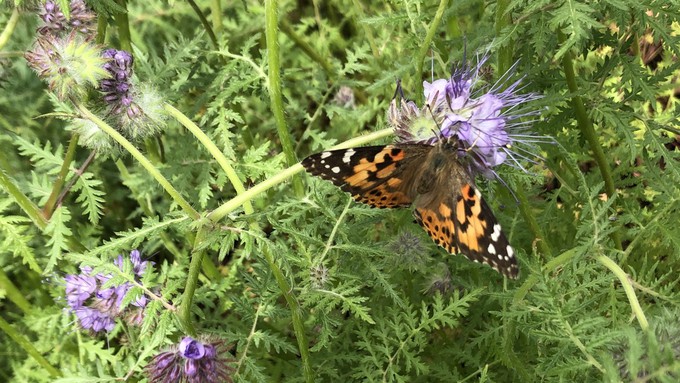
Yolo County master gardeners share advice on how to create a 'Wildlife Friendly Garden'

A painted lady butterfly enjoys the nectar of some lacy phacelia. In the Yolo master gardeners' online workshop Thursday, learn about plants that both humans and wildlife can enjoy. Kathy Morrison
October is the perfect time to plant most California natives, shrubs, trees and perennials – just the kind of flowering plants that attract more bees, butterflies and birds to your garden.
But what to plant? Which flowers do hummingbirds prefer? How about beneficial insects?
Find out during a free online seminar, hosted by the UC Cooperative Extension Master Gardeners of Yolo County and the Yolo County Library.
Set for 3 p.m. Thursday, Oct. 26, “Wildlife Friendly Garden” will show how people – especially in suburban or urban settings – can help native wildlife such as bees and birds through thoughtful gardening. By providing food and habitat, what you plant makes a big difference in their lives.
Yolo County Master Gardener Petra Unger will discuss how to plant a garden that’s both friendly to wildlife and people, say the organizers. “Learn how to best design, plant and grow your garden to maximize the benefits to wildlife and yourself.”
Unger’s advice works not only for Yolo County but all of the Central Valley and Sierra foothills. Since it’s on Zoom, the online workshop is available to a broad audience. Find the link here: https://yolomg.ucanr.edu/?calitem=570427&g=57253.
This workshop is part of an online series presented at 3 p.m. the second and fourth Thursdays of each month by the master gardeners and Yolo County Library. Set for Nov. 9, the next class: “What to Do in the November Garden?”
For more details: https://yolomg.ucanr.edu/.
Comments
0 comments have been posted.Sacramento Digs Gardening to your inbox.
Food in My Back Yard Series
May 6: Maintain soil moisture with mulch for garden success
April 29: What's (already) wrong with my tomato plants?
April 22: Should you stock up on fertilizer? (Yes!)
April 15: Grow culinary herbs in containers
April 8: When to plant summer vegetables
April 1: Don't be fooled by these garden myths
March 25: Fertilizer tips: How to 'feed' your vegetables for healthy growth
March 18: Time to give vegetable seedlings some more space
March 11: Ways to win the fight against weeds
March 4: Potatoes from the garden
Feb. 25: Plant a fruit tree now -- for later
Feb. 18: How to squeeze more food into less space
Feb. 11: When to plant? Consider staggering your transplants
Feb. 4: Starting in seed starting
Sites We Like
Garden Checklist for week of May 11
Make the most of the lower temperatures early in the week. We’ll be back in the 80s by Thursday.
* Plant, plant, plant! It’s prime planting season in the Sacramento area. Time to set out those tomato transplants along with peppers and eggplants. Pinch off any flowers on new transplants to make them concentrate on establishing roots instead of setting premature fruit.
* Direct-seed melons, cucumbers, summer squash, corn, radishes, pumpkins and annual herbs such as basil.
* Harvest cabbage, lettuce, peas and green onions.
* In the flower garden, direct-seed sunflowers, cosmos, salvia, zinnias, marigolds, celosia and asters. (You also can transplant seedlings for many of the same flowers.)
* Plant dahlia tubers.
* Transplant petunias, marigolds and perennial flowers such as astilbe, columbine, coneflowers, coreopsis, dahlias, rudbeckia and verbena.
* Keep an eye out for slugs, snails, earwigs and aphids that want to dine on tender new growth.
* Feed summer bloomers with a balanced fertilizer.
* For continued bloom, cut off spent flowers on roses as well as other flowering plants.
* Add mulch to the garden to maintain moisture. Mulch also cuts down on weeds. But don’t let it mound around the stems or trunks of trees or shrubs. Leave about a 6-inch-to-1-foot circle to avoid crown rot or other problems.
* Remember to weed! Pull those nasties before they set seed.
* Water early in the day and keep seedlings evenly moist.